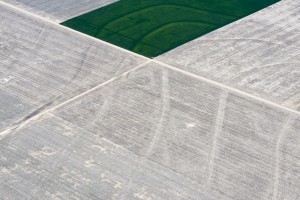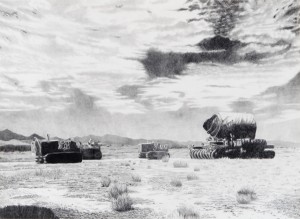The best visual art tends to possess these qualities: it engages the mind even as it captures the eye. Visual art missing both traits is a disaster; visual art missing one or the other quality motivates the viewer to move on, as either the eye gives up hope of stimulation, or the mind drifts away in search of a more interesting puzzle. Two distinct but conceptually related exhibits now showing at the Carmen Wiedenhoeft Gallery in Denver’s RiNo art district meet the criteria for the best in visual art. Imposition features the aerial landscape photography of Denver born and based Evan Anderman. Overlook, a pop-up exhibit in conjunction with the near-by Rule Gallery, features paintings and drawings of man-altered landscapes by Colorado born, now Santa Fe based, Nina Elder.
Imposition is the latest in Anderman’s growing oeuvre of aerial landscape art. This exhibit features ten large (most are 30×54”, the largest is 48×72”), visually stunning color aerial landscape photographs of the Eastern Plains of Colorado. The initial response to aerial landscapes is like that usually evoked by abstract art, as small telling details are at first overwhelmed by large scale shapes, colors, and textures. One piece in particular struck me as a play on the Color Field abstract art of the 50s and 60s. Fallow Fields is composed of strong geometrical shapes of neutral color capped by an almost implausibly iridescent green quadrilateral. The formalist in me thrilled when I looked upon this piece.

The formal beauty of each of Imposition’s images is the hook. One is inclined to gaze for a while from a leisurely distance to soak in the beauty, and only later move in to seek out the details. That’s when the questions arise, the inquiry begins, and a dialog ensues. Which shapes are natural, which made by man? What is that? How was it formed? Why is it there? Sometimes the image answers readily (e.g., tractor tracks, erosion, irrigation); sometimes it does not. In any case, the eye and mind are engaged.
The aerial landscape art on display here is the consequence of several significant developments that began in the last century. On the technical side were the developments of small, relatively affordable airplanes, and portable high resolution cameras and lenses. The subject of aerial photography, the land itself, underwent significant change, due to the emergence of monolithic agribusinesses that operate on geographic scales previously unimaginable, and the development of massively powerful machines that are capable of reshaping the contours and texture of the land to an extent not previously achievable by beast-drawn tools. No less significant a development was the evolution of the intent of the landscape photographer. The 20th century started with the Pictorialist, who endeavored merely to imitate Impressionist paintings. They were followed by early Modernists, who sought to evoke an emotional response to the sublime splendor of seemingly untouched nature. Emerging in the mid-70s were the New Topographics artists who could see no point in portraying pristine nature, given the overwhelming evidence of man’s despoilment. They presented an unflinching and often pessimistic view of man’s impact. Their work marked a turning point in landscape photography. Now we have contemporary landscape artists—artists like Evan Anderman—who are neither afraid to show man’s alteration of the land, nor afraid to reveal the beauty that sometimes accompany such change.
Imposition doesn’t answer the question of whether man’s alteration of the plains is good or bad. This exhibit doesn’t go there. But it does make one see and think about our man-altered world. We get to draw our own conclusions, whatever they may be. If landscape photography of the early 20th century sought to show us our land as we’d like to believe it is and hope it always will be, contemporary landscape photography seeks to show us our land as it actually is and likely will continue to be—that is, much altered by man, for good or for bad.

Overlook, although also contemporary landscape art, is less neutral than Imposition. Elder’s work tends more towards the New Topographics formulation—especially that of photographer Robert Adams—where human-created ugliness is presented in jarring counterpoint to the beauty of the surrounding land. A case in point is Jumbo (Trinity Test Site, April 7, 1945), a large (22×30”) graphite and charcoal drawing. A classic Southwestern desert landscape, complete with craggy mountains in the background, and a canopy of cirrus clouds overhead is the stage for huge earthmoving equipment, apparently employed in the preparation of the site for early nuclear weapons tests. While Elder claims in her artist statement that she approaches the post-industrial landscape as “pure spectacle”, the fact that she used radioactive (presumably low-level radioactive) charcoal in the Jumbo drawing, would indicate an intent to evoke a decidedly non-neutral reaction to this particular man-altered landscape.
Like the Imposition pieces, there is a lovely formal beauty to Overlook’s paintings and drawings. Overlook engages the eye and mind, even if the messages embedded in this work leave less room for personal interpretation than does Imposition. Imposition and Overlook make a stimulating pairing.
This dual exhibit at the Wiedenhoeft is unusual for a couple of reasons. Generally, Anderman exhibits his work at his own gallery, Journey Through Landscape. Nina Elder is a Rule artist, and the Wiedenhoeft and Rule galleries are rivals, if friendly rivals, in the emerging RiNo art scene. So I applaud all the parties involved for pulling together to create this wonderful show. The Denver art scene is the beneficiary of their collective efforts.
Imposition and Overlook are at the Carmen Wiedenhoeft Gallery through October 18th.